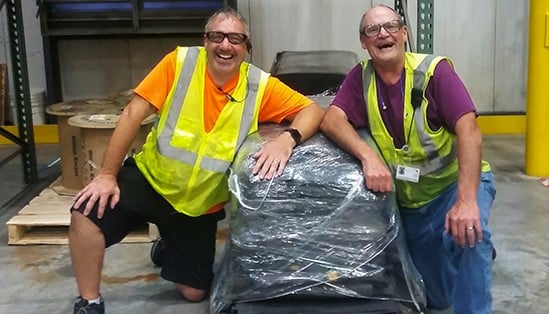The United Nations’ Sustainable Development Goals are the framework that governments, business and civil society use to drive the sustainability agenda. With those goals in mind, UPM Raflatac developed the Biofore Site™ concept and set responsibility targets for 2030 that aim to improve its environmental, social and economic performance. The aim is to build a site-specific roadmap that includes auditing, measuring and evaluating progress. The Biofore Site concept will facilitate growth of a strong sustainability culture and increase transparency.
One of the Biofore Site™ targets, as well as an UPM-level target, is for all production facilities to be landfill-free by 2030. Four UPM Raflatac facilities are already meeting the goal; the Changshu factory in China, the Nowa Wieś and Wrocław factories in Poland, and the Tampere factory in Finland. Our Nancy factory in France is virtually landfill free with only a tiny fraction of their waste stream still landfilled.
Opportunities for going landfill free vary around the world. Landfilling is still the most common and cost-effective option, and in many cases the only option, to dispose of waste at many locations where UPM Raflatac operates. In these situations, creative and committed work is required to find solutions to reduce landfilling. Dixon is one of the locations facing the challenge.

Rock MeKeel (on the right) and Mick Dolan (on the left) started collecting the single-use, slip-resistant rubber mats and sending them to the supplier’s facility for re-use.
Significant reduction in less than a decade
Finding suitable solutions and vendors for non-landfill waste management required the Dixon team to research, compare different options, and conduct a careful evaluation of the facility’s entire waste stream. Despite limited recycling options in the area, the Dixon team found vendors with workable solutions. Today cardboard, office paper, and plastic wrap are collected as a mixed stream that a waste vendor takes and sorts for re-processing. Another vendor accepts scrap metal for recycling. Trim and slabbed waste are taken by another vendor for incineration with energy recovery.
“As a result of cooperating with various vendors and being open to new options, the amount of waste landfilled from the Dixon facility has dropped 91% since 2009 and is the lowest relative landfill disposal rate, calculated in tonnes per Mm2 label stock produced, among the UPM Raflatac facilities that are not already landfill-free,” says Elizabeth Owens, Safety Coordinator, UPM Raflatac.
With their landfill reduction efforts, the Dixon factory has also been able to reduce the size of their waste containers from 40 cubic yards picked up once per week to 8 cubic yards picked up twice per week. Future efforts will aim at reducing the frequency of the 8-yard container pickups.
The Dixon team is open to new solutions
The Dixon team keeps their eyes open for new solutions to avoid landfilling. One example is collecting the single-use, slip-resistant rubber mats that arrive with every paper delivery. Dixon has teamed with a supplier to send these mats back to the supplier’s facility for re-use. Currently, roughly seven skids per month are shipped back, while Dixon reuses some mats for their own shipping needs.
“We encourage all facilities to regularly talk with waste vendors and suppliers to make sure we are aware of all waste management options besides landfilling – including recycling, reuse and energy recovery,” says Laura Cummings, Director, Health, Safety and Environment, UPM Raflatac.

UPM Raflatac aims to label a smarter future by improving the sustainability performance of its production sites through the Biofore Site™ concept. Our sustainability actions around the world clearly demonstrate that UPM Raflatac is the partner of choice for customers, end-users, suppliers and other stakeholders.